
Features
Production
Research
Simcoe ag research station opens doors to growers
opens doors to growers
April 17, 2008 By Marg Land
Fruit growers had an
opportunity to view the latest research trials involving apples,
peaches, nectarines, pears and berry crops during a recent open house
at the Simcoe Research Station.
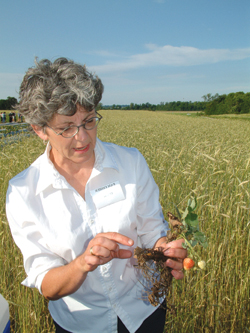 |
| Pam Fisher of OMAF describes root problems in strawberries during a recent open house at the Simcoe Research station. Photo by Margaret Land. |
Fruit growers had an opportunity to view the latest research trials involving apples, peaches, nectarines, pears and berry crops during a recent open house at the Simcoe Research Station.
The late afternoon event featured wagon tours of the facility’s 10 hectares of modern, intensive orchards, which are used for research conducted by the Ontario Ministry of Agriculture and Food, the University of Guelph and Agriculture and Agri-Food Canada. As well, demonstrations of orchard sprayers and hands-free tractor technology were also showcased. The event ended with visitors taking part in three field-based seminars involving irrigation, weed control plus disease and insect issues related to strawberry production. This was followed by an extensive walking tour of the station’s strawberry breeding program and variety trials.
Peaches
More than 100 people took part in the event, which started in the station’s orchards. Highlights of Ontario’s current peach and nectarine cultivar performance research were discussed, including the suitability of new Harrow and Vineland selections for production along the north shore of Lake Erie. According to Deb Norton, an agricultural technician at the station, researchers are hoping for their first crop of peaches in 2006 after cold temperatures in late January 2005 resulted in very little spring bloom.
Pears
The orchard at Simcoe also features a planting of pears, part of the AAFC and University of Guelph’s continued work on developing fire blight resistant cultivars for both fresh and processing markets. Every year, a number of pear seedling populations are produced through controlled pollination. While these populations are usually initially assessed for fire blight tolerance under greenhouse conditions before seedlings are planted out into orchards, a limited seedling population in 2000-2003 resulted in all seedlings being planted out to orchards in Simcoe and Vineland without being screened for susceptibility to fire blight.
“The first sign of fire blight, that cultivar is cut from the program,” explained AAFC researcher Dr. David Hunter.
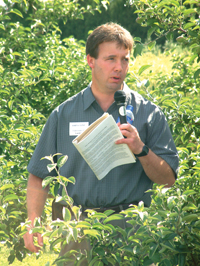 |
| Dr. John Cline of the Univ-ersity of Guelph. |
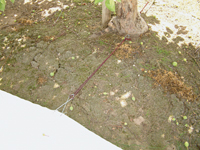 |
| The anchoring system used to keep fabric row covers under the trees. Photos by Margaret Land. |
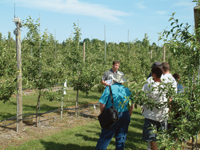 |
| Dr. Cline explains web-based irrigation scheduling. Photo by Margaret Land. |
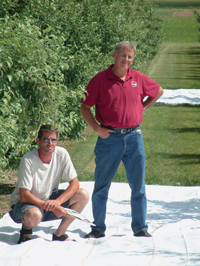 |
| Two tour participants listen with interest during discussion of fabric row covers to increase apple colour and sugar. Photo by Margaret Land. |
Orchard light management
In the facility’s apple orchards, highlighted research included a trial of light management options for high-density apple plantings. Jonathan Toye, president of Extenday, was on hand to showcase one of his products – a reflective, reusable fabric that allegedly enhances fruit production by improving fruit colour and sweetness while also increasing fruit size and yield. The fabric is laid in the orchard row and helps deflect sunlight up into the tree canopy, providing light to areas that would normally be shaded. According to Toye, the fabric has a five to six year lifespan if used for only four to five months per year. It comes in varying widths up to 16-feet and can cost anywhere from $1,000 to $3,000 (US) per acre to purchase.
“You don’t have to move it to spray,” Toye explained. “We have some orchards who drive over it up to 15 times a season.”
Grass growth is somewhat restricted under the fabric although mice are extremely fond of setting up house under its surface.
“I’m not saying this is something for everyone,” he added. “But some people can run with it and increase profitability. It’s a management tool.”
Irrigation
Another management tool currently being tested and researched at the Simcoe station is web-based irrigation scheduling for tree fruit. Dr. John Cline, an assistant professor with the University of Guelph’s tree fruit physiology and orchard management program, described the research, which is comparing three different irrigation models with no irrigation at all. The three models, which all involve trickle irrigation, include using Ontario Weather Network information to schedule irrigation using a probe which measures soil moisture (web-based), replacing three-quarters of the water lost through evaporation, calculated using an Atometer/ET Gauge) and the water
budget/balance method.
“We’re hoping to assemble all of the data and then growers would have the ability to log onto a website which, based on orchard location, can advise on irrigation,” said Dr. Cline.
This is the second year of the research project. Wet weather in 2004 resulted in no benefits being observed for orchards using irrigation scheduling.
“If it continues to be dry, we’ll see the benefits of irrigation by the end of the season. With high density, high cost orchards, the more you have invested, the more you are interested in ways to minimize the risk. Irrigation is one of those ways.”
Apple research
Dr. Cline also discussed some of his research work with chemical thinners on apples and the use of Apogee in vegetative growth control experiments, also on apples. With thinning, Simcoe research is based on examining the effectiveness of Maxcel, a new thinner similar to Accel but without gibberellic acid, on Honeycrisp, Empire, Gala and Cameo apple varieties. The best thinning method for Honeycrisp is also being examined using Carbaryl, Maxcel, NAA and a NAA/Carbaryl mix. As well, effective Gingergold cluster thinning is being studied using Maxcel, NAA, Sevin, a Sevin/Accel mix and a Sevin/NAA mix. Even though Apogee was registered for use on apples this past spring, research into its effectiveness continues, including its efficacy when used on Empire and Royal Gala during the 2005 season and whether it can cause fruit cracking in Empire apples. There is also a study underway examining whether Apogee has any benefits for suppressing the incidence of fire blight when used on immature fruit trees and whether it is able to suppress the incidence or spread of fire blight within an established orchard.
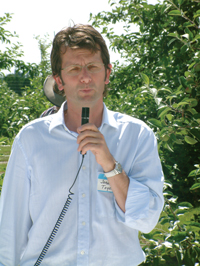 |
| Jonathan Toye, Extenday |
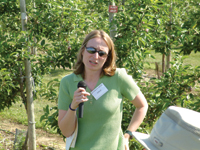 |
| Kathryn Carter, OMAF |
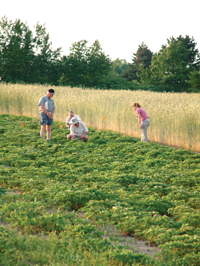 |
| Tour participants were encouraged to sample the wares during a tour of strawberry breeding plots. Photo by Margaret Land. |
Low-risk pesticides
Kathryn Carter, a pome fruit IPM specialist with OMAF, discussed her current work examining possible reduced risk pesticide products and technologies, which could be integrated into orchard production schedules as Canada’s Pest Management Regulatory Agency moves ahead with a reevaluation, and possible elimination, of organophosphate (OP)-based products.
One area these products are being examined is their effect on the populations of beneficial insects, the hypothesis being that if these products are low-risk, there should be a corresponding increase in beneficial insect populations.
“We’re not seeing the increase in beneficials, even with the low-risk chemistries,” said Carter, adding this could mean one of two things – “the beneficials already have OP resistance or the reduced risk chemistries aren’t as reduced risk as originally thought.”
Post harvest research
The on-going saga involving the Canadian registration of 1-MCP was also touched on by Dr. Jennifer DeEll, fresh market quality program lead with OMAF.
“Basically, it’s registered everywhere else in the world, but we’re struggling here,” she said.
Currently, the storage product has temporary registration in the country until December 2005. The PMRA is requesting further data, including comparisons of the 625 ppb rate used in the UK with the 1,000 ppb rate used in the U.S. plus the effectiveness of the product during six months of commercial air storage and 12 months of commercial controlled atmosphere storage. According to Dr. DeEll, these research trials are underway and should be completed by the fall.
Dr. DeEll is also involved with research examining the effect 1-MCP treatment may have on the possibility of carbon dioxide injury involving stored Empire apples. As well, other research work is also being conducted, examining how 1-MCP could impact apple quality if applied using current industry practices.
There has also been interest expressed in research examining the use of an in-field spray application of 1-MCP just prior to harvest. “We’ve found it’s just as effective as the gas when applied a week before harvest,” explained Dr. DeEll. “But I don’t know whether it’s practical to get a big tractor and sprayer into an orchard a week before harvest.”
Other post harvest research Dr. DeEll is involved in includes: an evaluation of new apple cultivars for browning potential as fresh-cut slices; using the CIPRA model to predict post harvest disorders in apples; determining the optimum post harvest handling and storage of Honeycrisp apples; evaluating applying DPA as a thermo-fog, rather than a drench, in commercial apple storage rooms, and studying the effects of 1-MCP on the quality of tender fruit in Ontario.
Strawberry issues
Information for small fruit producers wasn’t left out of the open house. Following a barbecue break and demonstrations of various tractors and orchard equipment, the wagons were loaded again for a quick trip to the station’s berry plots. Information sessions involving underground pests and above ground problems, detecting and spot treating problem weeds and monitoring for soil moisture, were held at three different sites within the berry research plots.
As well, University of Guelph professor and small fruit breeder Dr. Adam Dale took participants on a hike through various strawberry breeding and variety trials, inviting everyone to take samples and
critique potential cultivars along the way.
Print this page